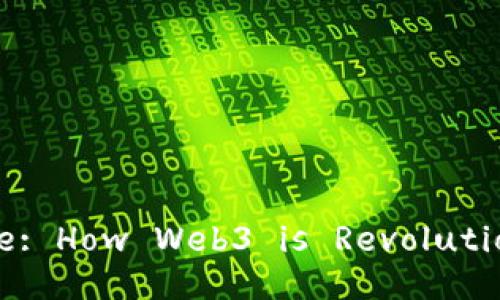Unlocking the Future: How Web3 is Revolutionizing the Intern
As the internet evolves, it is increasingly important to understand the implications of this evolution. Among the most groundbreaking developments is the concept of Web3. Web3, also known as the decentralized web, represents a fundamental shift in how we interact with digital information and applications. By leveraging blockchain technology, cryptocurrencies, and decentralized applications (dApps), Web3 aims to create a more open, user-centric internet that empowers individuals. In this article, we will explore the core principles of Web3, its potential applications, implications for various industries, and the challenges it faces in becoming mainstream.
What Is Web3 and How Does It Differ from Previous Versions of the Web?
To understand Web3, we must first reiterate the evolution of the web. The internet we use today can be categorized into three generations: Web1, Web2, and Web3.
Web1, or the static web, was primarily read-only. Users could access and consume information, but there was little interactivity. Websites were mostly static HTML pages, allowing for minimal user engagement.
Web2 introduced dynamic content and user-generated material. This version of the web is characterized by social media platforms, blogs, and interactive applications. However, it also brought about significant centralization, where large corporations had a monopoly on user data and content distribution. The implications of this centralization include privacy concerns, censorship issues, and a lack of user control over personal information.
Web3 aims to address these centralization issues by incorporating decentralized technologies. Built on blockchain, Web3 applications do not rely on a single point of failure, meaning they cannot be controlled or shut down by one entity. This democratized approach allows users to have greater ownership of their data, identity, and digital assets, leading to enhanced privacy and security.
How Does Web3 Utilize Blockchain Technology?

Blockchain technology serves as the backbone of Web3, providing a secure and transparent way to store and manage data. In a blockchain, transactions are recorded across a distributed network of computers, ensuring that data is immutable and cannot be altered without consensus from the majority of network participants.
One crucial aspect of blockchain technology is its ability to enable decentralized applications (dApps). Unlike traditional applications that require a central server, dApps operate on a blockchain network, allowing users to interact directly with each other without intermediary control. This creates a more equitable digital environment where users retain sovereignty over their activities and data.
Another significant aspect of blockchain in Web3 is smart contracts. Smart contracts are self-executing contracts with the terms of the agreement directly written into code. They enable trustless transactions, meaning users can engage in agreements without needing a trusted third party. This functionality has vast implications for various industries, including finance, supply chain management, real estate, and healthcare.
What are the Potential Applications of Web3?
The potential applications of Web3 are vast and varied. Here are several key areas where Web3 technologies can make a substantial impact:
1. Decentralized Finance (DeFi)
Decentralized finance refers to financial services built on blockchain technology that aim to provide an open and permissionless financial system. This includes lending, borrowing, trading, and investing without relying on traditional banks. Through DeFi, users can access financial products directly, often with lower fees and greater transparency.
2. Non-Fungible Tokens (NFTs)
Web3 has given rise to NFTs, unique digital assets that represent ownership of items or content on the blockchain. NFTs have disrupted traditional art, music, and gaming industries by allowing creators to monetize their work directly without intermediaries, leading to new forms of revenue and fan engagement.
3. Governance and DAOs (Decentralized Autonomous Organizations)
Web3 also enables the creation of DAOs, organizations that operate through smart contracts and community governance. DAOs allow stakeholders to have a say in decision-making processes, promoting a more democratic model of organizational governance.
4. Identity Verification and Management
Web3 technologies can enhance digital identity management by providing decentralized solutions for identity verification. Users can own and freely share their personal data, reducing the risk of identity theft and increasing privacy.
5. Supply Chain Transparency
Blockchain technology can improve supply chain transparency by tracking the movement of goods in real time. This can enhance trust between stakeholders, reduce fraud, and ensure ethical sourcing practices.
What Challenges Does Web3 Face in Becoming Mainstream?

While Web3 presents innumerable opportunities, several challenges may impede its widespread adoption. Understanding these hurdles is crucial for fostering the growth of a decentralized internet.
1. Scalability Issues
Blockchains, especially those supporting Ethereum, have faced scalability issues. Transaction speeds and capacities are often limited, leading to higher fees and slower processing times during periods of high demand. Solving these challenges is essential for the viability of Web3 technologies.
2. User Experience
The user experience of many Web3 applications still lags behind their Web2 counterparts. Complex interfaces, high learning curves, and the need for specific crypto wallets can deter average users from engaging with decentralized platforms. Simplifying these processes will be critical in attracting a broader audience.
3. Regulatory Uncertainty
Governments worldwide are still grappling with how to approach blockchain technologies and cryptocurrencies. Uncertainties surrounding regulations can create a lack of confidence for businesses and users, stalling innovation and adoption within the space.
4. Security Concerns
While blockchain technology is inherently secure, it is not immune to risks. Vulnerabilities in smart contracts or user error (e.g., lost private keys) can lead to significant losses. Educating users on security best practices is crucial for safeguarding digital assets in Web3.
5. Societal Resistance
Lastly, there may be broader societal resistance to adopting Web3 due to misconceptions about cryptocurrency and blockchain. Overcoming these perceptions through education and transparency will be necessary for encouraging mainstream participation.
What Are the Implications of Web3 for Privacy and Data Ownership?
As we shift toward a decentralized web, one of the most significant implications relates to privacy and data ownership. In the current Web2 landscape, users unwittingly give up control of their data to large corporations, which often exploit this information for profit. In contrast, Web3 endeavors to empower users by enabling true ownership of their data.
Web3 technologies allow individuals to store their personal information on decentralized platforms without central authority control. This shift means users can choose what to share, with whom, and to what extent. Enhanced privacy controls can prevent misuse of data by third parties and mitigate risks associated with data breaches.
Another important aspect is the concept of self-sovereign identity. Web3 promotes systems where individuals can create and manage their digital identities. This decentralization reduces dependency on third-party verification systems and enhances personal agency within the digital sphere.
How Will Web3 Transform Business Models?
Web3 has the potential to radically transform various business models across industries. Companies that embrace decentralization and enhance user ownership will likely find new opportunities for growth and engagement.
Traditional businesses may be compelled to adapt or reshape their models to remain competitive in a decentralized ecosystem. For example, Web3 can help businesses create tokenized loyalty programs that allow users to earn and trade tokens, providing greater flexibility compared to traditional points systems.
Moreover, content platforms can pivot toward a creator-economy model by leveraging blockchain technology. Artists can connect directly with their audiences, ensuring fair compensation for their work without relying on traditional distribution channels that take a significant cut of profits.
Ultimately, adopting Web3 principles encourages innovation and greater stakeholder empowerment. Companies that prioritize user sovereignty, security, and transparency stand to gain a competitive advantage in the evolving digital landscape.
What is the Future of Web3 and Its Impact on Society?
The vision of Web3 extends beyond technology; it encompasses a cultural and societal shift towards decentralization and empowerment. As Web3 technologies become fully realized, they will likely foster new forms of collaboration, governance, and social structures that prioritize community over corporate interests.
This shift could lead to increased trust within digital ecosystems, as users unite under shared values of transparency and governance. Moreover, by democratizing access to technology and resources, Web3 can help bridge socio-economic divides, enabling more individuals and communities to participate in the global digital economy.
As we look to the future, the continued development and integration of Web3 technologies can potentially redefine core societal norms around ownership, privacy, and control. However, to truly unlock the promise of a decentralized web, stakeholders must address the technical, regulatory, and educational challenges that remain. Only then can we fully realize a more connected, equitable, and empowered digital landscape.
In conclusion, Web3 is not just an innovative technological advancement; it serves as a catalyst for a broader metamorphosis of how we engage with the internet. By understanding its principles, applications, challenges, and implications, we can navigate this new frontier and play an active role in shaping the future of our digital experience.
